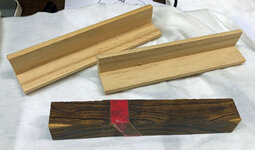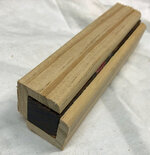Painfullyslow
Member
I am not having good luck with drilling for some of the larger diameter tubes on even very basically segmented blanks. I am sure that it is a combination of process and equipment and so I would like to ask for some advice.
I have been working lately on blanks requiring a 12.5mm tube. I am using a benchtop drill press and because I have metal layers I am using standard jobber bits, brand new and sharp.
To start, my drill press isn't high quality and I am sure there is some runout and I am drilling at 675rpm.
My process is center drilling bit to get things started then 7mm, 10.5mm, and finally 12.5mm bit. If disaster is going to strike, its always on the 12.5mm bit and always where there is a metal layer (brass or aluminum). The bit will snag and that's the end. It doesn't seem to matter how light I am with the pressure.
So, the obvious first question is if there is something wrong with my process. I am wondering if I should be skipping the 10.5mm step?
Secondly, I am looking at upgrading my lathe (I have a really tiny penpal) to some form of MIDI which I will ensure that it can handle drilling. Would I be better off drilling blanks on the MIDI or would I also need to upgrade my drill press to one which is better suited to the task at hand?
Any other general advice relating to all of this would be welcome.
I have been working lately on blanks requiring a 12.5mm tube. I am using a benchtop drill press and because I have metal layers I am using standard jobber bits, brand new and sharp.
To start, my drill press isn't high quality and I am sure there is some runout and I am drilling at 675rpm.
My process is center drilling bit to get things started then 7mm, 10.5mm, and finally 12.5mm bit. If disaster is going to strike, its always on the 12.5mm bit and always where there is a metal layer (brass or aluminum). The bit will snag and that's the end. It doesn't seem to matter how light I am with the pressure.
So, the obvious first question is if there is something wrong with my process. I am wondering if I should be skipping the 10.5mm step?
Secondly, I am looking at upgrading my lathe (I have a really tiny penpal) to some form of MIDI which I will ensure that it can handle drilling. Would I be better off drilling blanks on the MIDI or would I also need to upgrade my drill press to one which is better suited to the task at hand?
Any other general advice relating to all of this would be welcome.




